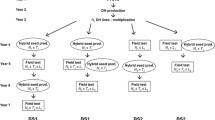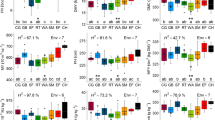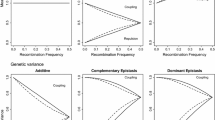Abstract
Parental selection influences the gain from selection and the optimum allocation of test resources in breeding programs. We compared two hybrid maize (Zea mays L.) breeding schemes with evaluation of testcross progenies: (a) doubled haploid (DH) lines in both stages (DHTC) and (b) S1 families in the first stage and DH lines within S1 families in the second stage (S1TC-DHTC). Our objectives were to (1) determine the optimum allocation regarding the number of crosses, S1 families, DH lines, and test locations, (2) investigate the impact of parental selection on the optimum allocation and selection gain (ΔG), and (3) compare the maximum ΔG achievable with each breeding scheme. Selection gain was calculated by numerical integration. Different assumptions were made regarding the budget, variance components, correlation between the mean phenotypic performance of the parents and the mean genotypic value of the testcross performance of their progenies (ρ P ), and the composition of the finally selected test candidates. In comparison with randomly chosen crosses, maximum ΔG was largely increased with parental selection in both breeding schemes. With an increasing correlation ρ P , this superiority increased strongly, while the optimum number of crosses decreased in favor of an increased number of test candidates within crosses. Thus, concentration on few crosses among the best parental lines might be a promising approach for short-term success in advanced cycle breeding. Breeding scheme S1TC-DHTC led to a larger ΔG but had a longer cycle length than DHTC. However, with further improvements in the DH technique and the realization of more than two generations per year, early testing of S1 families prior to production of DH lines would become very attractive in hybrid maize breeding.

Similar content being viewed by others
References
Baker RJ (1984) Quantitative genetic principles in plant breeding. In: Gustafson JP (ed) Gene manipulation in plant improvement. Plenum Press, New York, pp 147–176
Bernardo R (1996) Best linear unbiased prediction of maize single-cross performance. Crop Sci 36:50–56
Bernardo R (2002) Breeding for quantitative traits in plants. Stemma Press, Woodbury
Bernardo R (2003) Parental selection, number of breeding populations, and size of each population in inbred development. Theor Appl Genet 107:1252–1256
Choo TM, Christie BR, Reinbergs E (1979) Doubled haploids for estimating genetic variances and a scheme for population improvement in self-pollinating crops. Theor Appl Genet 54:267–271
Cochran WG (1951) Improvement by means of selection. In: Proc second Berkeley symp math stat prob, pp 449–470
Gallais A (1979) The concept of varietal ability in plant breeding. Euphytica 28:811–823
Gordillo GA, Geiger HH (2007) Optimizing of DH-line based recurrent selection procedures in maize under a restricted annual loss of genetic variance. Euphytica. doi:10.1007/s10681-007-9616-y
Hill WG, Caballero A, Dempfle L (1996) Prediction of response to selection within families. Genet Sel Evol 28:379–383
Hühn M (1996) Optimum number of crosses and progeny per cross in breeding self-fertilizing crops. I. General approach and first numerical results. Euphytica 91:365–374
Hühn M (2005a) Optimum number of crosses and progeny per cross in breeding self-fertilizing crops. II. Numerical results based on expected selection responses (special case). Cereal Res Commun 33:493–500
Hühn M (2005b) Optimum number of crosses and progeny per cross in breeding self-fertilizing crops. II. Numerical results based on expected selection responses (general case). Cereal Res Commun 33:501–508
Hühn M (2006) Optimum number of crosses and progeny per cross in breeding self-fertilizing crops. III. Economic constraints. Cereal Res Commun 34:903–910
Longin CFH, Utz HF, Melchinger AE, Reif JC (2006a) Hybrid maize breeding with doubled haploids: comparison between selection criteria. Acta Agron Hung 54:343–350
Longin CFH, Utz HF, Reif JC, Schipprack W, Melchinger AE (2006b) Hybrid maize breeding with doubled haploids: I. One-stage versus two-stage selection for testcross performance. Theor Appl Genet 112:903–912
Longin CFH, Utz HF, Melchinger AE, Reif JC (2007a) Hybrid maize breeding with doubled haploids: II. Optimum type and number of testers in two-stage selection for general combining ability. Theor Appl Genet 114:393–402
Longin CFH, Utz HF, Reif JC, Wegenast T, Schiprack W, Melchinger AE (2007b) Hybrid maize breeding with doubled haploids: III. Efficiency of early testing prior to doubled haploid production in two-stage selection for testcross performance. Theor Appl Genet 115:519–527
Melchinger AE (1988) Means, variances, and covariances between relatives in hybrid populations with disequilibrium in the parent population. In: Weir BS, Eisen EJ, Goodman MM, Namkoong G (eds) Proc second int conf quantit genet. Sinnauer, Sunderland, pp 400–415
Melchinger AE, Longin CFH, Utz HF, Reif JC (2005) Hybrid maize breeding with doubled haploid lines: quantitative genetic and selection theory for optimum allocation of resources. In: Proceedings of the forty first annual Illinois corn breeders’ School 2005, Urbana-Champaign, USA, pp 8–21
Röber F, Gordillo GA, Geiger HH (2005) In vivo haploid induction in maize—performance of new inducers and significance of doubled haploid lines in hybrid breeding. Maydica 50:275–283
Schmidt W (2004) Hybridmaiszüchtung bei der KWS SAAT AG (in German). In: Bericht über die 54. Tagung der Vereinigung der Pflanzenzüchter und Saatgutkaufleute Österreichs 2003, Gumpenstein, Austria, pp 1–6
Schnell FW (1982) A synoptic study of the methods and categories of plant breeding. Z Pflanzenzuecht 89:1–18
Schön CC, Utz HF, Groh S, Truberg B, Openshaw S, Melchinger AE (2004) Quantitative trait locus mapping based on a vast maize testcross experiment and its relevance to quantitative genetics for complex traits. Genetics 167:485–498
Seitz G (2005) The use of doubled haploids in corn breeding. In: Proceedings of the forty first annual Illinois corn breeders’ School 2005, Urbana-Champaign, USA, pp 1–7
Sprague GF, Federer WT (1951) A comparison of variance components in corn yield trials: II. Error, year × variety, location × variety and variety components. Agron J 42:535–541
Utz HF (1969) Mehrstufenselektion in der Pflanzenzüchtung (in German). Arbeiten der Universität Hohenheim, vol 49, Verlag Eugen Ulmer, Stuttgart
Utz HF (1982) Der Selektionserfolg in spaltenden Generationen mit experimentellen Untersuchungen und Modellrechnungen (in German). Professorial dissertation, Universität Hohenheim, Stuttgart
Wricke G, Weber WE (1986) Quantitative genetics and selection in plant breeding. Walter de Gruyter, Berlin, pp 41–65, 172–179, 214–218
Wright AJ (1974) A genetic theory of general varietal ability for diploid crops. Theor Appl Genet 45:163–169
Zhong S, Jannink J-L (2007) Using QTL results to discriminate among crosses based on their progeny mean and variance. Genetics 177:567–576
Acknowledgments
This research was supported by funds from DFG, Grant No 1070/1, International Research Training Group “Sustainable Resource Use in North China” to T. Wegenast. The authors thank Dr. W. Schipprack, Institute of Plant Breeding, Seed Science, and Population Genetics, University of Hohenheim, Stuttgart, Germany for his valuable suggestions. In addition, the authors appreciate the editorial work of Dr. J. Muminović, whose suggestions considerably improved the style of the manuscript. We greatly appreciate the helpful comments and suggestions of the anonymous reviewer.
Author information
Authors and Affiliations
Corresponding author
Additional information
Communicated by H. C. Becker.
T. Wegenast and C. F. H. Longin contributed equally to this work.
Electronic supplementary material
Below is the link to the electronic supplementary material.
Rights and permissions
About this article
Cite this article
Wegenast, T., Longin, C.F.H., Utz, H.F. et al. Hybrid maize breeding with doubled haploids. IV. Number versus size of crosses and importance of parental selection in two-stage selection for testcross performance. Theor Appl Genet 117, 251–260 (2008). https://doi.org/10.1007/s00122-008-0770-y
Received:
Accepted:
Published:
Issue Date:
DOI: https://doi.org/10.1007/s00122-008-0770-y




